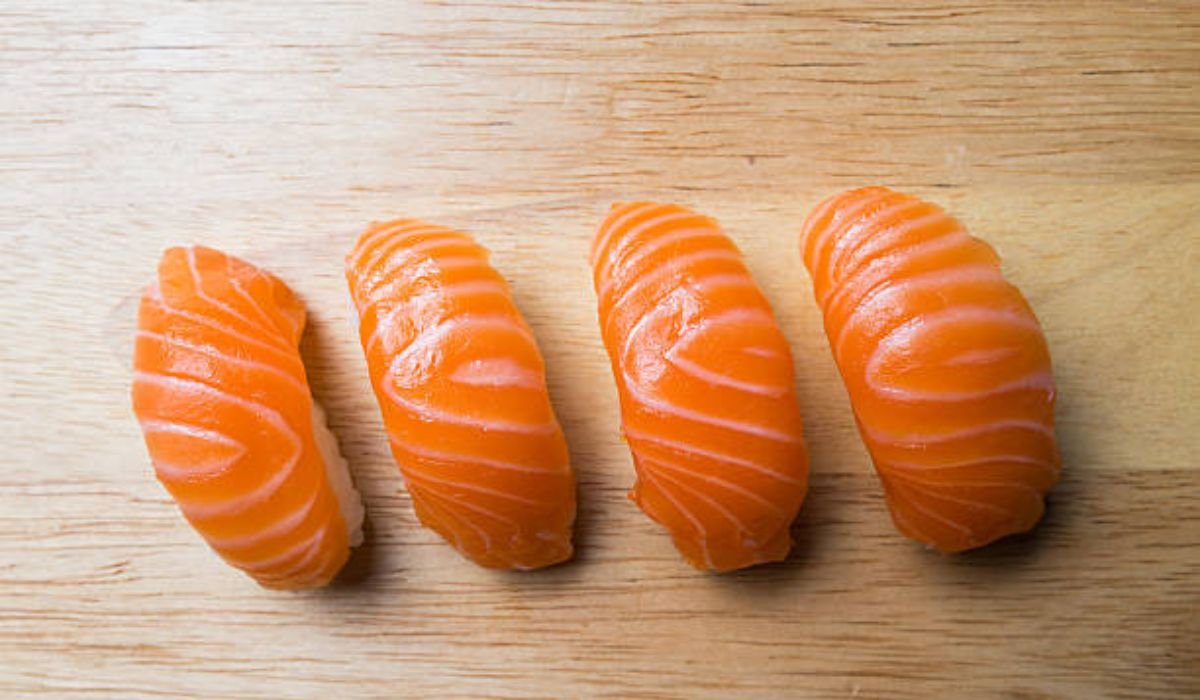Have you ever been handed a sushi menu and felt a sudden, overwhelming uncertainty? You know you want salmon, but the choices are staggering. Sashimi, nigiri, rolls, aburi… where do you even begin? If you’ve ever wondered how to perfect that ideal sushi order topped with salmon nyt, you’re not alone. This seemingly simple dish is a gateway to a deeper appreciation of Japanese cuisine, a topic so captivating it’s even graced the pages of The New York Times. Let’s dive into the world of glistening, orange-pink salmon and craft the order of your dreams.
At its heart, this is exactly what it sounds like: a foundation of seasoned sushi rice, crowned with a slice of premium salmon. But oh, the magic is in the details. Think of it as a culinary canvas where the salmon is the star artist. The quality, cut, and preparation of the fish transform this simple combination into an experience.
Fundamentally, you’re looking at a few key styles:
- Nigiri: The classic. A small, hand-pressed oblong of vinegared rice with a thin slice of raw salmon draped over it. A tiny bit of wasabi is often hidden between the rice and fish, creating a perfect, one-bite harmony.
- Sashimi: While not technically “sushi” since it omits the rice, sashimi is the purest expression of the salmon itself. It’s just expertly sliced, raw fish, allowing you to appreciate its pristine texture and flavor without distraction.
- Gunkan Maki: Meaning “battleship roll,” this is a nigiri-style base wrapped with a strip of nori (seaweed) to form a cup, which is then “topped” with a salmon-based mixture like spicy mayo-coated salmon or salmon roe (ikura).
Understanding these basic forms is your first step to ordering with confidence.
Walk into any sushi bar from Tokyo to Tennessee, and you’ll find salmon as a cornerstone. Its popularity isn’t an accident. For one, its vibrant color is visually irresistible, a promise of richness on the plate. But the real appeal is on the palate.
Salmon’s high fat content gives it an unctuous, buttery texture that melts in your mouth—a quality known as otoro in the tuna world, but accessible here at a friendlier price point. Its flavor is robust yet approachable, less “fishy” than many other options, making it a perfect entry point for sushi novices and a consistent favorite for connoisseurs.
Furthermore, the rise of high-quality, sustainably farmed salmon, particularly from places like Norway, has made this fish a reliable, year-round staple. This availability and consistency mean chefs can always offer it, and diners can always count on it. It’s the reliable friend on the menu that never lets you down.
This is where the fun begins. Let’s translate the menu terms so you can build your perfect plate.
The Salmon Variety Show
Not all salmon is created equal. When you place your sushi order topped with salmon nyt, you might encounter:
- Sake: This is the standard, go-to raw salmon. It’s typically Atlantic or King Salmon, prized for its fatty, clean taste.
- Sake Toro: The belly cut of the salmon. This is the premium, extra-fatty section. If you see this, order it. It’s the ultimate indulgence, with a silken texture that is truly unforgettable.
- Aburi Sake: “Aburi” means flame-seared. The chef briefly torches the top of the salmon nigiri with a blowtorch. This caramelizes the fats, creating a smoky, rich flavor and a contrasting texture between the warm, cooked surface and the cool, raw interior.
- Ikura: Salmon roe. These are the large, orange, glistening eggs that pop with a briny, oceanic flavor. They are often served as gunkan maki.
Building a Balanced Plate
A great sushi experience is about variety. Instead of ordering six pieces of the same thing, try a combination.
- For the Traditionalist: 2 pieces of Sake Nigiri, 2 pieces of Sake Toro Nigiri, and a gunkan of Ikura.
- For the Adventurer: 1 piece of Sake Nigiri, 1 piece of Aburi Sake Nigiri, and a salmon-focused roll like a Salmon Avocado Roll.
- The Pure Tasting: A plate of Sake Sashimi to appreciate the fish alone, followed by a piece of Aburi Sake for a different experience.
Table: Your At-a-Glance Salmon Sushi Guide
| Term | What It Is | Flavor & Texture Profile | Best For |
| Sake (Nigiri/Sashimi) | Standard raw salmon | Buttery, mild, soft | The classic beginner & expert favorite |
| Sake Toro | Fatty salmon belly | Rich, ultra-buttery, melts in mouth | A luxurious treat |
| Aburi Sake | Lightly seared salmon | Smoky, rich, warm top/cool center | Those who like cooked & raw flavors |
| Ikura (Gunkan) | Salmon roe (eggs) | Salty, briny, “popping” texture | A burst of ocean flavor |
Read also: Grouse Cheese: A Bold Taste of the Wild
The world of sushi is always evolving. Today, chefs are getting creative with their salmon offerings. You might find items like:
- Salmon Truffle Nigiri: Topped with a thin shaving of black truffle for an earthy, aromatic punch.
- Spicy Salmon Roll: A modern classic, often made with minced salmon mixed with a spicy mayo sauce, rolled with cucumber or avocado.
- Crispy Salmon Skin Roll: Utilizing the often-discarded skin, fried until crackling, adding a fantastic textural contrast.
Don’t be afraid to ask your server what the chef’s special salmon preparation is for the day. This is often where you’ll find the most inspired creations.
You’ve placed your order. The beautiful plate arrives. Now what?
- Soy Sauce Etiquette: For nigiri, it’s considered proper to turn the piece upside down and lightly dip the fish side—not the rice—into the soy sauce. This prevents the rice from absorbing too much liquid and falling apart.
- Wasabi Wisdom: Respect the chef. Often, they will have placed a small, perfectly calibrated amount of wasabi between the rice and fish. Try it first before adding more.
- The Ginger Reset: The pickled ginger (gari) is a palate cleanser. Eat a slice between different types of fish to refresh your taste buds, not on top of the sushi itself.
Maybe you’re not dining out. Maybe you’re picking up takeout or even trying your hand at making sushi yourself. The principles remain the same. Look for salmon that is labeled “sushi-grade” or “sashimi-grade” from a reputable fishmonger. The flesh should be bright, firm, and smell fresh and clean, not fishy. When assembling, let the salmon shine. A great tip for homemade nigiri is to slightly form the rice with wet hands to prevent sticking, and let the weight of the salmon slice hold it in place.
Ordering sushi shouldn’t be intimidating. It’s a personal journey of taste and discovery. Now that you’re armed with the knowledge of different cuts, preparations, and etiquette, you can walk into any sushi bar with confidence.
- Start Simple: Begin with classic Sake nigiri to taste the baseline.
- Indulge in Variety: Add a piece of Toro or Aburi for contrast.
- Explore Textures: Don’t forget a bite of Ikura for that popping sensation.
- Trust the Chef: Ask for an omakase (chef’s selection) style if you’re feeling adventurous.
- Savor the Moment: Eat it soon after it’s served, and appreciate the craft.
What’s your favorite way to enjoy salmon sushi? Do you have a go-to order that you swear by? Share your experiences and let’s keep the conversation going!
1. Is the salmon on sushi always raw?
Most commonly, yes. The classic preparations like sake (nigiri/sashimi) are raw. However, styles like aburi (seared) involve a quick pass with a flame, which lightly cooks the surface while leaving the interior raw. Cooked salmon may also appear in some specialty rolls.
2. What’s the difference between salmon in sushi and smoked salmon?
They are fundamentally different. Sushi salmon is raw, fresh fish. Smoked salmon has been cured and hot- or cold-smoked, giving it a firm, flaky texture and a distinctive smoky flavor. They are not interchangeable in traditional sushi.
3. Is it safe to eat raw salmon on sushi?
Yes, when sourced and handled correctly. Reputable sushi restaurants use “sashimi-grade” salmon, which has been frozen to temperatures that kill parasites, as mandated by FDA guidelines. Always ensure you are dining at a clean, trustworthy establishment.
4. Why is my salmon sushi sometimes so orange and other times pale pink?
The color can vary by species and diet. Wild salmon get their pink-orange color from eating krill and shrimp. Farmed salmon are often fed a diet that includes astaxanthin, a natural pigment, to achieve that familiar hue. A deeper color isn’t always an indicator of better quality.
5. What does “sake” mean in the context of sushi?
This is a classic point of confusion! In Japanese, the word for salmon sushi is “sake” (pronounced sah-keh). The alcoholic drink is “sake” too (pronounced sah-kee), but the context makes it clear. The salmon belly is “sake toro.”
6. Can I make salmon sushi at home?
Absolutely! The key is sourcing the right fish. You must purchase salmon that is explicitly labeled “sushi-grade” or “sashimi-grade” from a reputable supplier. Do not use regular grocery store salmon fillets intended for cooking, as they may not have been handled to be consumed raw.
7. What are the little orange eggs on top of sushi?
Those are salmon roe, known as ikura. They are large, individual eggs that pop in your mouth, releasing a salty, briny liquid. They are a delicacy and are typically served in a small gunkan (battleship) style roll.
You may also like: Decoding the Art of the Salmon Wrapped Sushi Order NYT-Style

